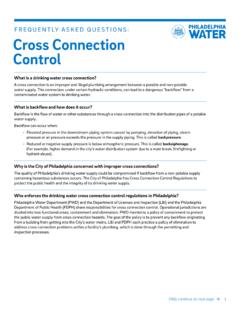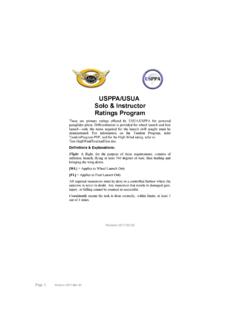Transcription of 2017 Water Supply Cross Connection Report Form
1 MICHIGAN DEPARTMENT OF ENVIRONMENT, GREAT LAKES, AND ENERGY DRINKING Water AND ENVIRONMENTAL HEALTH DIVISION 2019 Water Supply Cross Connection Report Issued under authority of 1976 PA 399, as amended, MCL et seq., and its administrative rules. Failure to submit this form is a violation of the Act and may subject the Water Supply to enforcement actions. EGLE Environmental Assistance Center EQP2016 Telephone: 1-800-662-9278 Page 1 of 1 Rev. 4/2020 Return the completed form by March 31, 2020, to the appropriate Department of Environment, Great Lakes, and Energy (EGLE) district office to comply with administrative Rule R that states a Water utility shall Report annually to the department on the status of the Cross Connection control program on a form provided by the department.
2 For district office addresses, visit and then click on District Offices Map and Contact Information. WSSN: A. Name of Water system: County: B. Year that the current written Cross Connection control program was approved by EGLE: C. Total number of industrial, commercial, institutional, residential, and governmental accounts that must be routinely reinspected for Cross connections: Of this number, - How many are High Hazard accounts: Frequency of Reinspection: Once per: - How many are Low Hazard accounts: Frequency of Reinspection: Once per: D.
3 Number of accounts from line C that received an initial inspection in 2019: E. Total number of reinspections required and completed in 2019 based on degree of hazard: - High hazard reinspections required: High hazard reinspections completed: - Low hazard reinspections required: Low hazard reinspections completed: F. Number of accounts where a Cross Connection (s) was found to exist during inspections or reinspections in 2019: G.
4 Number of accounts from line F where corrective actions have been completed: H. Total number of accounts from line C which are now in compliance with the local Cross Connection control program; H = C (F - G): I. Total number of backflow prevention devices in system requiring testing: J. Number of backflow prevention devices tested in 2019: Outline briefly any changes or significant findings since last reporting. Use additional sheets if necessary.
5 Narrative Description of Program: Name: Title: Date: 2019 Water Supply Cross Connection Report EQP2016 Instructions for completing the Water Supply Cross Connection Report Definitions: Inspection: The initial visit to an account to determine whether the potential for a Cross Connection exists. Reinspection: Any of the following activities: 1. A periodic, scheduled return visit to ensure that air gaps and protective devices are in place and operating properly.
6 The frequency of this type of reinspection is determined after the initial inspection and is based on the degree of hazard. An example of this type of reinspection is a yearly visit to a facility with a chemically treated boiler with an RPZ device installed. 2. A visit made at the request of a customer due to flow, Water quality, or other problems, during which the Water utility checks for Cross connections. An example of this type of reinspection is a visit to investigate a taste and odor complaint that includes examining several vacuum breaker installations.
7 3. A follow-up visit to confirm that a customer has eliminated a discovered Cross Connection or installed an appropriate protective device. An example of this type of reinspection is a return visit 30 days after a Cross Connection is discovered to confirm that a suitable air gap has been installed at a mixing tank as required by the Water utility. A, B. This is basic information to be provided by the Water system. C. This is the total number of accounts requiring routine reinspections. Some Water accounts, due to a very low degree of Cross Connection hazard, are not routinely reinspected and should not be included on this line.
8 Because high-hazard and low-hazard accounts may have different reinspection frequencies, they should be listed separately. D. This is the number of accounts that were new to your program during the year and have received their initial inspection. E. This is the number of inspections that should have been completed during the year based on the information provided in C, compared to the number actually completed. As an example calculation, a Water system with 20 high-hazard accounts (requiring annual reinspections) and 50 low-hazard accounts (requiring inspections every 2 years) would have a total of 45 inspections due for the year (all 20 of the high-hazard accounts, plus one-half of the low-hazard accounts).
9 F. Any Cross connections discovered during the year that required corrective action should be included on this line. Corrective actions include creation of an air gap, installation of a backflow prevention device, repair of a defective device, elimination of improper bypasses around devices, etc. G. Accounts where a reinspection has been completed to confirm that the discovered Cross Connection was eliminated, or an appropriate protective device was installed, should be included on this line. H. The value from line G should first be subtracted from line F, and the result should be subtracted from line C to obtain the value for this line.
10 I, J. The device testing frequency is set by the Water utility based on the degree of hazard. The number listed in J may be less than the number listed in I, because some devices may require less than annual testing. Narrative Description of Program: Any pertinent information, such as system-wide public education activities, loss of accounts due to facility closure or change of owner/tenant, significant enforcement, etc. should be included in this section.














